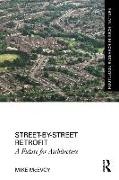Read more
Central to the book is the presentation of domestic street by street retrofit as an issue with technical, financial, and societal dimensions. A holistic view of the complex, interacting factors that have held back any advance is interspersed with a historical account of retrofit's faltering progress over the last twenty years.
List of contents
List of FiguresForeword: What If the Just Transition Began at Home?
AcknowledgementsIntroduction Part I: The State of the Art 1 Which Way to Jump?Case Study: Energiesprong2 The Carrying Capacity of the PlanetThe Anthropocene and natureSustainable development, its origins and implicationsEcomodernism and the magic of technologyThe climate crisis and the crisis of cultureCultural junctureCase Study: EU IFORE Innovation for Renewal3 Re-evaluation of ModernismTipping pointRegulationAlternative directionsThe ecomodernist direction: Geo-engineeringCase Study: Parity Projects4 Sustainable RetreatTechnology (alone) is not the answerThe future slowdownThe idea of progressModernism and the natural worldArchitecture as a belief systemCase Study: Link Road, Birmingham5 Caring ArchitectureThe future role of the architect will be to build sparinglyBuilding little implies making good what we already have i.e. retrofitPart II: A Brief History of Retrofit 6 Size of the ProblemThe energy case for retrofitProblem #1 Determining the Outcomes7 Pre-requisites for RetrofitRetrofit at the urban scaleRetrofit originsThe 40 per cent houseProblem #2 Insulation8 Drivers for ChangeProblem #3 Overheating9 Home Truths40 per cent house to achieving zeroProblem #4 Ventilation10 Anticipating the Green Deal Problem #5 Airtightness11 Retrofit Comes to a HaltProblem #6 Renewables12 Measuring Success: 80% Reduction and 'Retrofit for the Future'Low carbon BritainProblem #7 The occupants13 The Progress of RetrofitRetrofit and performanceArchitects as retrofit leadersArchitectural skills required?Part III: Towards a New Utopia 14 The Art of the ImaginationRetrofit realignedRetrofit and utopia15 The Problem of TheoryThe politics of architectureCapitalism and creative destructionModernism and radical politics16 Architecture's Very Uniquely Compromised PositionThe roots of Modernism: Hannes Meyer and the New Objectivity (Neue Sachlichkeit)The hidden aspects of consciousness, the uncanny, Gothic and SurrealismUrban ecology17 Echoes from the Past: Herbert MarcuseSociety as a work of artRetrofit as the representation of society as a work of artMarcuse's utopia of hope, utopia as a realisable dreamRetrofit as subversive art18 Retrofit and Architects: A FutureArchitects and innovation - Our utopian missionArchitecture or extinctionIndex
About the author
Mike McEvoy studied at Cambridge prior to registration as an architect, then went on a postgraduate scholarship to Cornell; his PhD is from the Bartlett. He was in practice in the United States and Canada and for a decade with Arup Associates in London. Subsequently, he was Coordinator of Technical Studies at the University of Westminster; on the faculty at Cambridge and a Fellow Commoner of Downing College; and latterly, Professor of Architecture at the University of Brighton, where he led EU IFORE an Anglo/French EUR6.3million street-by-street retrofit programme (which is the background to this book). Previously, he had completed, and published, the outcomes of several funded research projects into low-energy construction. He has written three other books on architectural technology:
Architecture and Construction in Steel, External Components, and
Environmental Construction Handbook.
Summary
Central to the book is the presentation of domestic street by street retrofit as an issue with technical, financial, and societal dimensions. A holistic view of the complex, interacting factors that have held back any advance is interspersed with a historical account of retrofit’s faltering progress over the last twenty years.

